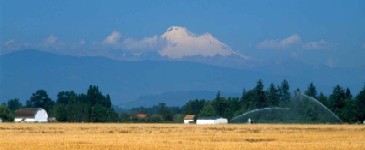http://www.nature.org:80/wherewework/northamerica/states/washington/misc/art21531.html


Three farmers in Washington’s Skagit River Delta in
northwest Washington State are adding a new crop to their
fields
— shorebirds. By flooding parts of
their fields with two or three inches of water for part of
each year, the farmers are hoping to create new or improved
habitat for shorebirds such as Western sandpipers,
black-bellied plovers, dunlins, and marbled godwits, and at
the same time improve the health of the fields for farming.
The farmers, David Hedlin, Alan Mesman, and
Gail Thulen, are participating in an innovative research
project The Nature Conservancy has launched in cooperation
with Washington State University, the U.S. Environmental
Protection Agency, Skagitonians to Preserve Farmland, and
Western Washington Agricultural Association.
Called “Farming for Wildlife,” the
three-year project will study the relationship between three
farming practices mowing, grazing, and flooding and habitat
for migratory shorebirds. The intent of the experiment is to
discover how habitat rotation can be compatible with crop
rotations in the Skagit Valley.
The Skagit Delta Community
The Skagit Delta is a vibrant rural community—one of the
last strongholds of farming in Western Washington and a
bread basket both regionally and nationally. The local
community is rightfully proud and protective of its family
farming heritage, which reaches back for generations.
At the same time,
the delta is rich in wildlife. Though altered over the years
by human development, diking and draining, the delta
continues to support tidal marshes and riverine habitats
which host one of the largest and most diverse
concentrations of wintering raptors on the continent.
And in recent
winters, biologists surveying the delta have counted more
than 150,000 dabbling ducks and more than 65,000 shorebirds,
underscoring its status as a critical stop along the Pacific
Flyway.
For the Birds
Scientists have
documented the decline of 14 species of migrating shorebirds
that rely on near-shore and estuary habitats, said Kevin
Morse, the Conservancy’s Skagit Delta project manager. The
Skagit Delta “is one of the last best places for shorebirds.
But they’ve lost this type of habitat along their migratory
routes,” Morse said.
The three farmers
have each committed about 70 acres of land to the three-year
Farming for Wildlife project. They’ll employ mowing,
grazing, and flooding on different portions of their land,
and then scientists will evaluate the effects of each
practice on both soil and the varieties and abundance of
shorebirds.
Farmers will be
compensated for their time and expenses in the project, up
to a total of $350,000. The project is funded by the
Environmental Protection Agency, the Puget Sound Marine
Fund, and private donations.
A Win for Farmers as well as Fliers
In
addition to compensation for time and
expenses, the farmers can benefit from a grant from the
Pacific Coast Joint Venture Discretionary Fund. This
grant will sponsor an informational trip by some of the
participating farmers and other agricultural stakeholders in
the Skagit Delta to Tule Lake National Wildlife Refuge in
the Klamath Basin region of Northern California.
Working with the
U.S. Fish and Wildlife Service, farmers there have
discovered that certain wetland rotations have increased
their yields by 25 percent and reduced costs by some $200 an
acre because they no longer needed pesticides to manage
soil-borne pests.
It turns out that
keeping a field in grass or sheet pond for three years,
which improves soil fertility, could also enable the farmers
to transition to organic status if they were looking for a
way to do so, since federal organic standards require
farmland to be pesticide-free for three years.
The real payoff
will come if The Nature Conservancy learns which practices
are successful and can be replicated in other areas of the
country. As part of the study, the Conservancy will
rigorously monitor use of the habitat by shorebirds at
different tide heights, as well as the presence of weeds,
invertebrates in the soil, and overall soil condition. If
significantly higher numbers of shorebirds are feeding in
the pilot fields than in neighboring farm fields, and the
soil condition is measurably improved, and farmers embrace
the treatments, that will spell success. The study is
expected to be completed in May 2010.
“If 100 years from
now,” farmer Dave Hedlin said, “there are healthy viable
family farms in this valley and waterfowl and wildlife and
salmon in the river, then everyone wins.”
Photos © Keith Lazelle and Kirsten Morse

